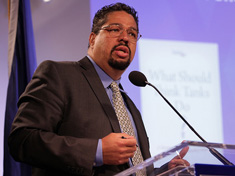-
Roger-Mark De Souza: Focus on Urban Dynamics, Water Scarcity in Latin America and the Caribbean
July 31, 2015 By Linnea Bennett For the past four decades, urbanization in Latin American and Caribbean countries has been on the rise. Today it’s one of the most urbanized regions of the world with 79 percent of the population living in towns and cities. By 2050, 9 out of 10 residents are expected to live in cities. This density and movement of people is critical to understanding the region’s water and climate change issues, says ECSP’s Roger Mark De Souza in this week’s podcast.
For the past four decades, urbanization in Latin American and Caribbean countries has been on the rise. Today it’s one of the most urbanized regions of the world with 79 percent of the population living in towns and cities. By 2050, 9 out of 10 residents are expected to live in cities. This density and movement of people is critical to understanding the region’s water and climate change issues, says ECSP’s Roger Mark De Souza in this week’s podcast.For the past four decades, urbanization in Latin American and Caribbean countries has been on the rise. Today it’s one of the most urbanized regions of the world with 79 percent of the population living in towns and cities. By 2050, 9 out of 10 residents are expected to live in cities. This density and movement of people is critical to understanding the region’s water and climate change issues, says ECSP’s Roger Mark De Souza in this week’s podcast.
As Latin American cities have grown, infrastructure hasn’t necessarily kept up. There is a natural variability in access to water across the region, and inequality within urban areas in terms of access to services and infrastructure is quite high as well. Women are disproportionately impacted, as they are often responsible for fetching household water by hand. The ratio of women to men in poor households increased eight percent between 1997 and 2012. What’s more, 150 million people are expected to be added to the region by 2050, says De Souza.
Between 12 and 81 million people will face water shortages by 2020Many Andean countries rely on glaciers for freshwater, and others require vast amounts of water to sustain booming agricultural industries. But by some projections, between 12 and 81 million people will face water shortages by 2020 as glacial melt and saltwater infiltration affect drinking water availability, agricultural production, and tourism.
He calls for an approach to building resilience that cuts across and addresses natural environmental factors (e.g., water sources), man-made environmental factors (infrastructure, politics), and demographic factors (gender, socioeconomic characteristics).
Migration patterns, density, and gender dynamics can provide critical insights into how water is being used, and provide helpful lenses for policies that make a sustainable impact. Conversely, analyzing how climate change is straining natural resources can help policymakers understand certain demographic repercussions that result from that stress, like political and social stability.
Countries should look to understand the broad range of source options within a water system as well as what sources can serve as alternatives if others are disrupted. Connectivity between cities and countries is also critical to building climate resilience, says De Souza, as it can help smooth out variability. “There have been attempts to think of how we could encourage water companies to share or trade water. Are there ways that we can get different groups of users to trade water allocations so that patterns of use could shift as water availability changes?”
But De Souza said all of this work must circle back to one critical theme. “Can water keep up with these population dynamics in the region?”
Roger-Mark De Souza spoke at the Wilson Center on July 28.
Friday Podcasts are also available for download on iTunes.
Sources: UN Environment Program, UN Habitat.
 A Publication of the Stimson Center.
A Publication of the Stimson Center.

 For the past four decades, urbanization in Latin American and Caribbean countries has been on the rise. Today it’s one of the most urbanized regions of the world with 79 percent of the population living in towns and cities. By 2050, 9 out of 10 residents are
For the past four decades, urbanization in Latin American and Caribbean countries has been on the rise. Today it’s one of the most urbanized regions of the world with 79 percent of the population living in towns and cities. By 2050, 9 out of 10 residents are 

